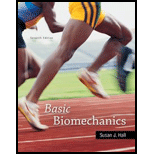
Basic Biomechanics
7th Edition
ISBN: 9780073522760
Author: Susan J Hall
Publisher: McGraw-Hill Education
expand_more
expand_more
format_list_bulleted
Concept explainers
Question
Chapter 9, Problem 7AP
Summary Introduction
To explain: The loss in spinal flexibility of approximately 50% is a result of aging process.
Concept introduction: Aging is a natural and irreversible process that starts after birth. The aging process is based on a person’s congenital traits, health status, and lifestyle. The body cells, tissues, and organs are collectively affected by aging and these changes have an effect on homeostasis. Several musculoskeletal changes will occur in the body as a part of aging.
Expert Solution & Answer
Want to see the full answer?
Check out a sample textbook solution
Chapter 9 Solutions
Basic Biomechanics
Ch. 9 - INTRODUCTORY PROBLEMS 1. What regions of the spine...Ch. 9 - INTRODUCTORY PROBLEMS 2. Construct a chart listing...Ch. 9 - INTRODUCTORY PROBLEMS Construct a chart listing...Ch. 9 - INTRODUCTORY PROBLEMS Construct a chart listing...Ch. 9 - INTRODUCTORY PROBLEMS How would trunk movement...Ch. 9 - INTRODUCTORY PROBLEMS What are the postural...Ch. 9 - INTRODUCTORY PROBLEMS Weight training is used in...Ch. 9 - INTRODUCTORY PROBLEMS What exercises strengthen...Ch. 9 - Prob. 9IPCh. 9 - Solve Sample Problem 9.1 using the following data:...
Ch. 9 - Prob. 1APCh. 9 - ADDITIONAL PROBLEMS 2. What exercises should be...Ch. 9 - ADDITIONAL PROBLEMS 3. Compare and contrast the...Ch. 9 - Prob. 4APCh. 9 - Prob. 5APCh. 9 - ADDITIONAL PROBLEMS 6. Formulate a theory...Ch. 9 - Prob. 7APCh. 9 - Prob. 8APCh. 9 - ADDITIONAL PROBLEMS 9. What spinal exercises are...
Knowledge Booster
Learn more about
Need a deep-dive on the concept behind this application? Look no further. Learn more about this topic, bioengineering and related others by exploring similar questions and additional content below.Similar questions
- What movements) occur(s) at the scapulae when you shrug your shoulders?arrow_forwardWhich of the following helps an agonist work? a synergist a fixator an insertion an antagonistarrow_forwardThe location of a muscles insertion and origin can determine ________. action the force of contraction muscle name the load a muscle can carryarrow_forward
- A muscle that has a pattern of fascicles running along the long axis of the muscle has which of the following fascicle arrangements? circular pennate parallel rectusarrow_forwardWatch this video (http://openstaxcollege.org/l/TMJ) to learn about TMJ. Opening of the mouth requires the combination of two motions at the temporomandibular joint, an anterior gliding motion of the articular disc and mandible and the downward hinging of the mandible. What is the initial movement of the mandible during opening and how much mouth opening does this produce?arrow_forwardThe large muscle group that attaches the leg to the pelvic girdle and produces extension of the hip joint is the ________ group. gluteal obturator adductor abductorarrow_forward
- Movement at the shoulder joint that moves the upper limb laterally away from the body is called ________. elevation eversion abduction lateral rotationarrow_forwardWhich muscle pair plays a role in respiration? intertransversarii, interspinales semispinalis cervicis, semispinalis thoracis trapezius, rhomboids diaphragm, scalenearrow_forwardThe muscles of a professional sprinter are most likely to have ________. 80 percent fast-twitch muscle fibers and 20 percent slow-twitch muscle fibers 20 percent fast-twitch muscle fibers and 80 percent slow-twitch muscle fibers 50 percent fast-twitch muscle fibers and 50 percent slow-twitch muscle fibers 40 percent fast-twitch muscle fibers and 60 percent slow-twitch muscle fibersarrow_forward
- Watch this video (http://openstaxcollege.org/l/micromacro) to learn more about macro- and microstructures of skeletal muscles. (a) What are the names of the junction points between sarcomeres? (b) What are the names of the subunits within the myofibrils that run the length of skeletal muscle fibers? (c) What is the “double strand of pearls� described in the video? (d) What gives a skeletal muscle fiber its striated appearance?arrow_forwardThe radius bone ________. is found on the medial side of the forearm has a head that articulates with the radial notch of the ulna does not articulate with any of the carpal bones has die radial tuberosity located near its distal endarrow_forwardWhich of the following is not a true statement comparing exoskeletons and endoskeletons? Endoskeletons can support larger organisms Only endoskeletons can grow as an organism grows Exoskeletons provide greater protection of the internal organs Exoskeletons provide less mechanical leverage.arrow_forward
arrow_back_ios
SEE MORE QUESTIONS
arrow_forward_ios
Recommended textbooks for you
 Principles Of Radiographic Imaging: An Art And A ...Health & NutritionISBN:9781337711067Author:Richard R. Carlton, Arlene M. Adler, Vesna BalacPublisher:Cengage Learning
Principles Of Radiographic Imaging: An Art And A ...Health & NutritionISBN:9781337711067Author:Richard R. Carlton, Arlene M. Adler, Vesna BalacPublisher:Cengage Learning Anatomy & PhysiologyBiologyISBN:9781938168130Author:Kelly A. Young, James A. Wise, Peter DeSaix, Dean H. Kruse, Brandon Poe, Eddie Johnson, Jody E. Johnson, Oksana Korol, J. Gordon Betts, Mark WomblePublisher:OpenStax College
Anatomy & PhysiologyBiologyISBN:9781938168130Author:Kelly A. Young, James A. Wise, Peter DeSaix, Dean H. Kruse, Brandon Poe, Eddie Johnson, Jody E. Johnson, Oksana Korol, J. Gordon Betts, Mark WomblePublisher:OpenStax College Fundamentals of Sectional Anatomy: An Imaging App...BiologyISBN:9781133960867Author:Denise L. LazoPublisher:Cengage Learning
Fundamentals of Sectional Anatomy: An Imaging App...BiologyISBN:9781133960867Author:Denise L. LazoPublisher:Cengage Learning Human Physiology: From Cells to Systems (MindTap ...BiologyISBN:9781285866932Author:Lauralee SherwoodPublisher:Cengage Learning
Human Physiology: From Cells to Systems (MindTap ...BiologyISBN:9781285866932Author:Lauralee SherwoodPublisher:Cengage Learning Biology 2eBiologyISBN:9781947172517Author:Matthew Douglas, Jung Choi, Mary Ann ClarkPublisher:OpenStax
Biology 2eBiologyISBN:9781947172517Author:Matthew Douglas, Jung Choi, Mary Ann ClarkPublisher:OpenStax

Principles Of Radiographic Imaging: An Art And A ...
Health & Nutrition
ISBN:9781337711067
Author:Richard R. Carlton, Arlene M. Adler, Vesna Balac
Publisher:Cengage Learning

Anatomy & Physiology
Biology
ISBN:9781938168130
Author:Kelly A. Young, James A. Wise, Peter DeSaix, Dean H. Kruse, Brandon Poe, Eddie Johnson, Jody E. Johnson, Oksana Korol, J. Gordon Betts, Mark Womble
Publisher:OpenStax College

Fundamentals of Sectional Anatomy: An Imaging App...
Biology
ISBN:9781133960867
Author:Denise L. Lazo
Publisher:Cengage Learning

Human Physiology: From Cells to Systems (MindTap ...
Biology
ISBN:9781285866932
Author:Lauralee Sherwood
Publisher:Cengage Learning

Biology 2e
Biology
ISBN:9781947172517
Author:Matthew Douglas, Jung Choi, Mary Ann Clark
Publisher:OpenStax
